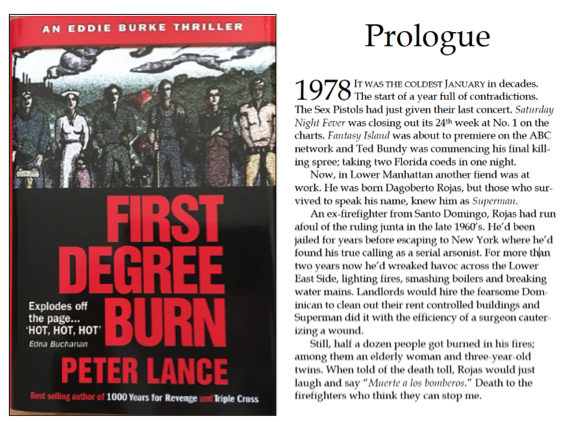FIRST DEGREE BURN: Reds vs. Blues
THE REDS VS. THE BLUES The rivalry between the NYPD and the FDNY ran broad and ran deep. Historically both departments were manned from the Irish enclaves, filled with the progeny of immigrants from Kerry, Mayo and Cork. But as in all tribes, there was a pecking order and among New York cops it was commonly held that “the Blues got the best and the Reds got the rest.”
If you were Italian and you came up in the city, you
had several options: become a cop, become a priest or
”get made.” But when it came to public service, there was
only one choice for the working-class Mick: you wore a gun
and chased predicate felons or you screamed through the
streets in an American LaFrance and chased fires.
Somewhere along the line, the fiction developed that cops led a more dangerous life. God knows enough of them went down in the line. It seemed like every week there was another video picture of blue men in sad rows at a grave site. But the truth was that the life expectancy in a ghetto engine company was far shorter. Inner city firefighters put their stones on the line ten times a day in the “hot” seasons. They got blown out of windows, suffocated by toxins, crushed to death under floor joists and drenched in burning in flammables with such regularity that death had become a routine and the funerals almost never drew air time.
They were rewarded for their heroism by having their hoses slashed with machetes or trashcans of burning swill thrown at their trucks, and more than a few men had been shot off their ladders by snipers angry that any representative of ”the man” would venture into “the hood.” The myth was that they spent their days shining fire poles and watching soap operas. But fire fighting was a dangerous life and emotions ran deep in these men who resented the attention cops got.
You see, unlike their uniformed brothers, firefighters had none of the opportunities for “private advancement.” Except for a few inspectors, the rank and file in a ladder company had no chance for a bribe. The unmentioned “pad” didn’t exist for these men. So in their minds, they took all the risks with few of the residual “benefits.”
Though their base pay, health and pensions were comparable, the men of the New York Police Department seemed to always come first in the hierarchy.
The Police Academy often took the first sons. The cops always marched first past St. Patrick’s on March 17th. And many an Emerald Society communion breakfast ended in fist fights as the men of the FDNY sought to correct this disparity.
 There was a notorious incident in ’78 captured with a
front page Daily News headline that read:
”Battle of The Badges.”
There was a notorious incident in ’78 captured with a
front page Daily News headline that read:
”Battle of The Badges.”
Rumors had been floating that the NYPD’s Emergency Services Unit was about to take over all rescue work, a large part of which was handled by the FDNY’s elite Rescue companies. On this particular day, there was an ”entrapment” in Brooklyn, meaning a motorist had been pinned in his car after a crash.
The FDNY’s 105 Truck responded and immediately deployed a Hurst Tool (“the jaws of life”) to cut out the poor man before he bled to death. Suddenly an ESU unit pulled up and an argument broke out over who was going to save the guy first. Well, one thing led to another and one of the firefighters knocked a uniformed cop to the ground.
The Blues radioed their Precinct and were ordered to withdraw. The motorist was freed. Finally, 105 Truck “took up” as the Reds call it when they leave a scene. Then, on the way back to the firehouse, a pair of police radio patrol units literally cut the truck off.
Two sets of uniforms jumped out. They pulled the firefighter who’d thrown the punch off the rig. He ended up “back-cuffed” under his Cairns helmet with his turnout coat and boots on.
There was simply no love lost between these men.
And so it was, that when the unmarked Chevy pulled up outside the crime scene on Prince Street, the driver was prepared for a fight. Eddie Burke looked for all the world like a cop. He dressed like a middle-grade detective in the same single breasted wool worsted: $155 off the rack at Sy Syms.
He carried a Smith & Wesson .38 in a Pachmyer holster at the small of his back. There was even a badge in his wallet and clipped to the roof of the Chevy with a magnet was the same blinking red Mars light, known to cops as the “Kojak bubble.”
He had the same face: the ruddy complexion from Bantry Bay; the cobalt blue eyes and the same killer smile you see in many early 30’s Irish-Americans before the drink kills their will. In fact, the only thing about him that would set him apart from a precinct detective was his shoes.
There was a standing joke in The Bureau of Fire Investigation that the one sure way to tell a Fire Marshal from a cop was by looking down at his feet. The Marshal was the one with the “dirty shoes.”
Eddie Burke was FDNY. And even though he’d come from a family of Blues, even though his old man had been a legend in the NYPD, he knew that he was not welcome here.




Recent Comments